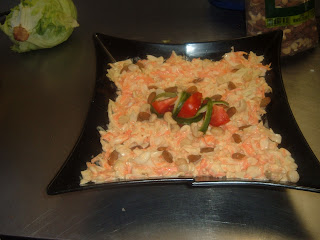Skills Proficiency in Food Preparation:
This was by far the most interesting course for me. I’ve enjoyed every moment in the kitchen, just a pity it was only for 3weeks. I’ve learned a lot of new things in the kitchen and enjoyed to have the opportunity to work in every section of the kitchen. I’ve also realized how important it is that everyone in the kitchen work together as a team to get all the work done in time and to be able to always do your best to ensure that the end product of the food are according to the companies standards and is prepared in a hygienic save environment and served in time. Here is some things I’ve learned during the 3 weeks :
Chef Uniform:
The beanie: is used to cover your head in order to prevent hair from falling in to the food.
Apron: is worn over the chef jacket and around the midsection to protect the uniform as well as the Chef.
Chef jacket: have long sleeves to protect your arms and is double breasted to protect the body even more from spills, slashes, heat and steam. The double breasted jacket have two flaps that can be changed for example if the front of the jacket become soiled then the dirty flap can be hidden underneath the clean flap in order to create a better appearance.
Pants: must be long in order to protect your lower body and legs.
Shoes: must be high-quality, supportive and protective because it must support you for very long hours of standing every day. Hard leather shoes with slip-resistant soles are recommended, both for support and protection.
Some Cooking Methods:
1. Blanching:
This is the treatment of spinach, peas and beans, in other words green vegetables, that preserve chlorophyll and break down plant acids. It also remove natural bitterness from strong flavoured vegetables, onions and cabbage families.
2. Boiling:
Cooking of food in rapid boiling water or other liquids.
It is also applicable to simmering of vegetables and meat.
3. Deep Frying:
Food that are being totally submerged in oil at 160˚C -180˚C. The food must be dry and at room temperature before putting it into the hot oil to prevent the oil from splashing.
4. Shallow Frying:
When food is put into oil just covering half the medium of the food.
.
5. Sautéing/ Sauter:
Quick frying of food in a pan with little oil, medium to high heat.
6. Gratinating:
Food prepared au gratin has a high fat content and is browned on the surface. For example gratinating cheese on the pizza.

7. Baking:
Cooking food in dry air, moistened by its ingredients.
8. Roasting:
Cooking food in dry heat at 150˚C – 175˚C.
4 Vegetable Cuts:
First we had a class of knives skills where we learned how to use knives safely and how to work with knives as well as how to hold knives right and how to cut right with knives. Then we’ve learned this 4 vegetable cuts:
1. Chiffonade:
This is used when cutting leafy vegetables in fine stripes.
2. Julienne:
Matchstick cuts that are 2mm x 3cm.
3. Brunoise:
Is cut out of julienne and is 2mm x 2mm cubed/diced.
4. Mire-Poix:
Rough cuts, size and shapes are less important. Is used for stocks, soups and sauses.
The different kinds of Cutting Boards:
We use different kind of cutting boards for different kinds of food during food preparation in order to prevent cross contamination between food and to ensure that food is hygienically save.
Red : For Raw meat.
Yellow: Chicken and Poultry.
Brown: For Cooked meat.
White : For Bread and Dairy.
Green: For Fruits and Vegetables.
Blue: For Fish and shell fish.
Mini Fruit Filled Doughnuts
Some of the food items I’ve made during my course in the kitchen:
<--Basic Green Salad
Biltong salad-->
<--Chicken salad
<--Brie and Blue cheese salad -->
<--Cabbish Salad
Basic Flat Bread with Cheese -->
<--Baking pancakes
Potato salad -->
<-- Baking Pizza
Working in the Bakery:




























No comments:
Post a Comment